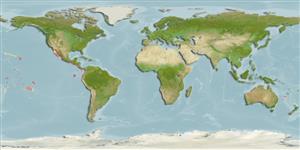>
Anguilliformes (Eels and morays) >
Ophichthidae (Snake eels) > Ophichthinae
Etymology: Myrichthys: Greek, myros, -ou = male of morey eel + Greek, ichthys = fish (Ref. 45335).
More on author: Girard.
Issue
Synonym of M. xysturus accdg. to Ref. 6852.
Environment: milieu / climate zone / distribuzione batimetrica / distribution range
Ecologia
marino associati a barriera corallina; distribuzione batimetrica 0 - 60 m (Ref. 5227). Tropical; 32°N -
Eastern Pacific: Gulf of California to Peru, including the Galapagos Islands.
Size / Peso / Age
Maturità: Lm ? range ? - ? cm
Max length : 74.0 cm TL maschio/sesso non determinato; (Ref. 5227); common length : 60.0 cm TL maschio/sesso non determinato; (Ref. 55763)
Short description
Chiavi di identificazione | Morfologia | Morfometria
Inhabits sandy and muddy bottoms, from shallow waters up to a depth of 25 m. Can be seen at times in daylight searching for prey under rocks and in crevices over rocky bottoms, or buried completely in the sand when inactive (Ref. 6852).
Life cycle and mating behavior
Maturità | Riproduzione | Deposizione | Uova | Fecundity | Larve
McCosker, J.E. and R.H. Rosenblatt, 1995. Ophichthidae. Tiesos, serpentones. p. 1326-1341. In W. Fischer, F. Krupp, W. Schneider, C. Sommer, K.E. Carpenter and V. Niem (eds.) Guia FAO para Identification de Especies para lo Fines de la Pesca. Pacifico Centro-Oriental. 3 Vols. FAO, Rome. (Ref. 9328)
IUCN Red List Status (Ref. 130435: Version 2025-1)
Threat to humans
Harmless
Human uses
Pesca: di nessun interesse
Strumenti
Special reports
Download XML
Fonti Internet
Estimates based on models
Preferred temperature (Fonte Biblio.
123201): 20.5 - 28.7, mean 25.9 °C (based on 80 cells).
Phylogenetic diversity index (Fonte Biblio.
82804): PD
50 = 0.5005 [Uniqueness, from 0.5 = low to 2.0 = high].
Bayesian length-weight: a=0.00091 (0.00039 - 0.00215), b=2.99 (2.79 - 3.19), in cm total length, based on LWR estimates for this (Sub)family-body shape (Ref.
93245).
Trophic level (Fonte Biblio.
69278): 3.5 ±0.5 se; based on size and trophs of closest relatives
Resilienza (Fonte Biblio.
120179): Medio, tempo minimo di raddoppiamento della popolazione 1.4 - 4.4 anni (Preliminary K or Fecundity.).
Fishing Vulnerability (Ref.
59153): Moderate to high vulnerability (50 of 100).
🛈
Nutrients (Ref.
124155): Calcium = 38.4 [21.5, 68.0] mg/100g; Iron = 0.511 [0.313, 1.025] mg/100g; Protein = 18.8 [16.5, 21.3] %; Omega3 = 0.111 [0.051, 0.312] g/100g; Selenium = 46.4 [26.9, 90.0] μg/100g; VitaminA = 50.4 [15.2, 149.8] μg/100g; Zinc = 0.95 [0.68, 1.31] mg/100g (wet weight);
